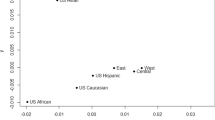Abstract
A total of 103 fragments in the STR D12S391 locus were sequenced. 24 different alleles were found which can be grouped into 12 allelic classes based on the total number of repeats. The structure of this compund STR consists of blocks of (AGAT) and (AGAC) repeats with a consensus structure (AGAT)8–l7 (AGAC)6–10 (AGAT)0–1. Whereas shorter alleles only have (AGAT) repeats, > 225 bp alleles are more complex, having two motifs (AGAT) and (AGAC). Population data showed that this to be a highly polymorphic STR with a heterozygosity of 0.9. This fact together with its simple structure make this STR very suitable for forensic and genetic purposes.
Similar content being viewed by others
References
Brinkmann B (1992) The use of STRs in stain analysis. In: Proceedings from the Third International Symposium on Human Identification. Promega Corporation, Madison, USA, pp 357–373
Brinkmann B (1996) The STR approach. In: Carracedo A, Brinkmann B, Bär W (eds) Advances in forensic haemogenetics 6. Springer, Berlin Heidelberg (in press)
DNA recommendations-1992 report concerning recommendations of the DNA Commission of the International Society for Forensic Haemogenetics relating to the use of PCR-based polymorphisms. Int J Legal Med 105:63–64
DNA recommendations-1994 report concerning further recommendations of the DNA Commission of the International Society for Forensic Haemogenetics regarding PCR-based polymorphisms in STR systems. Int J Legal Med 107:159–160
Edwards A, Civitello A, Hammond HA, Caskey CT (1991) DNA typing and genetic mapping with trimeric and tetrameric tandem repeats. Am J Hum Genet 49:746–756
Edwards A, Hammond HA, Jin L, Caskey CT, Chakraborty R (1992) Genetic variation at five trimeric and tetrameric tandem repeat loci in four human population groups. Genomics 12: 241–253
Fisher RA (1951) Standard calculations for evaluating a blood group system. Heredity 5:95–102
Guo SW, Thompson EA (1992) Performing the exact test of Hardy-Weinberg proportion for multiple alleles. Biometrics 48:361–372
Hauge XY, Litt M (1993) A study of the origin of shadows bands seen when typing dinucleotide repeat polymorphisms by the PCR. Hum Mol Genet 2:411–415
Kimpton CP, Walton A, Gill P (1992) A further tetranucleotide repeat polymorphism in the vWF gene. Hum Mol Genet 1:28
Lareu MV, Barros F, Salas A, Pestoni C, Muñoz I, Rodríguez-Calvo, MS, Carracedo A (1996). D12S391: a highly useful STR for forensic purposes. in: Carracedo A, Brinkmann B, Bär W (eds) Advances in forensic haemogenetics 6. Springer, Berlin Heidelberg (in press)
Litt M, Luty JA (1989) A hypervariable microsatellite revealed by in vitro amplification of a dinucleotide repeat within the cardiac muscle actin gene. Am J Hum Genet 44:397–401
Maniatis T, Fritsch EF, Sambrook, J (1989) Molecular cloning: a laboratory manual. Cold Spring Harbor Laboratory, Cold Spring Harbor, New York
Möller A, Brinkmann B (1994) Locus ACTBP2 (SE33). Sequencing data reveal considerable polymorphism. Int J Legal Med 106:262–267
Nei M, Roychoudhury AK (1974) Sampling variances of heterozygosity and genetic distance. Genetics 76:379–390
Ohno Y, Sebetan IM, Akaishi S (1982) A simple method for calculating the probability of excluding paternity with any number of codominant alleles. Forensic Sci Int 19:93–98
Pestoni C, Lareu MV, Rodréguez MS, Muñoz I, Barros F, Carracedo A (1995) The use of the STRs HUMTHOI, HUMVWA31/ A, HUMF13A1, HUMFES/FPS, HUMLPL in forensic application. Int J Legal Med 107:283–290
Tautz D (1989) Hypervariability of simple sequences as a general source for polymorphic DNA markers. Nucleic Acids Res 17: 6463–6471
Urquhart A, Kimpton CP, Downes TJ, Gill P (1994) Variation in short tandem repeat sequences. Int J Legal Med 107:13–20
Weber JL, Mayr PE (1989) Abundant class of human DNA polymorphisms which can be typed using the polymerase chain reaction. Am J Hum Genet 44:388–396
Author information
Authors and Affiliations
Rights and permissions
About this article
Cite this article
Lareu, M.V., Pestoni, C., Carracedo, A. et al. A highly variable STR at the D12S391 locus. Int J Leg Med 109, 134–138 (1996). https://doi.org/10.1007/BF01369673
Received:
Revised:
Issue Date:
DOI: https://doi.org/10.1007/BF01369673



